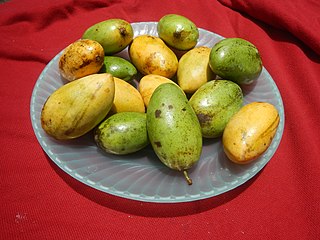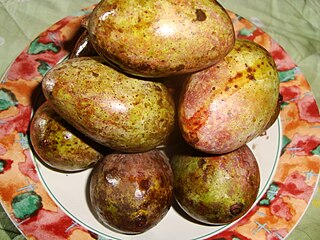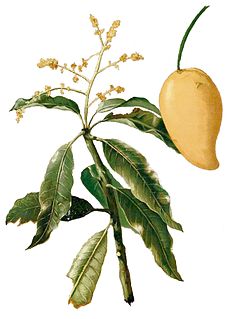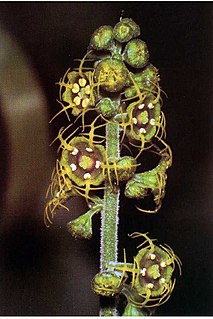
Ceiba pentandra is a tropical tree of the order Malvales and the family Malvaceae, native to Mexico, Central America and the Caribbean, northern South America, and to West Africa. A somewhat smaller variety is cultivated in southern and southeast Asia. Kapok is a name used in English speaking countries for both the tree and the cotton-like fluff obtained from its seed pods. In Spanish speaking countries the tree is commonly known as "ceiba". The tree is cultivated for the seed fibre, particularly in south-east Asia, and is also known as the Java cotton, Java kapok, silk-cotton or samauma.

A mango is a stone fruit produced from numerous species of tropical trees belonging to the flowering plant genus Mangifera, cultivated mostly for their edible fruit. Most of these species are found in nature as wild mangoes. The genus belongs to the cashew family Anacardiaceae. Mangoes are native to South Asia, from where the "common mango" or "Indian mango", Mangifera indica, has been distributed worldwide to become one of the most widely cultivated fruits in the tropics. Other Mangifera species are grown on a more localized basis.

Mangifera is a genus of flowering plants in the cashew family, Anacardiaceae. It contains approximately 69 species, with the best-known being the Common Mango. The center of diversity is in subtropical and tropical South Asia and Southeast Asia, while the highest number of species occur in India. They are generally canopy trees in lowland rainforests, reaching a height of 30–40 m (98–131 ft).

Ceiba is a genus of trees in the family Malvaceae, native to tropical and subtropical areas of the Americas and tropical West Africa. Some species can grow to 70 m (230 ft) tall or more, with a straight, largely branchless trunk that culminates in a huge, spreading canopy, and buttress roots that can be taller than a grown person. The best-known, and most widely cultivated, species is Kapok, Ceiba pentandra, one of several trees called kapok.
Indica is classical Greek and Latin for "of India". It may refer to:

Mangifera caesia is a species of flowering plant in the cashew family, Anacardiaceae. Common names include jack, white mango, binjai, wani, yaa-lam, bayuno/baluno/belunok and mangga wani. It belongs to the same genus as the mango and is widely cultivated in areas of Indonesia, Malaysia, Singapore, Brunei, Papua New Guinea and the Philippines.

Mangifera altissima, is a species of mango native to the Philippines and surrounding regions in Indonesia, Malaysia, Papua New Guinea and the Solomon Islands. It is not grown commercially but is harvested from the wild in the Philippines. It has small fruits that are pale yellow when ripe and are very sweet, though much more fibrous than commercially cultivated Mangifera indica species like Carabao mangoes. It is threatened by habitat loss.
Mangifera austro-indica is a species of plant in the family Anacardiaceae. It is native to Karnataka and Tamil Nadu in India.

Mangifera casturi is a species of plant in the family Anacardiaceae.

Mangifera foetida is a species of plant in the family Anacardiaceae. It is found in wet-land rainforest regions of Indonesia, Malaysia, Myanmar, Singapore, Thailand, and Vietnam.

Mangifera odorata is a species of plant in the family Anacardiaceae. It is commonly found along coastal towns or travel routes in Southeast Asia. "Also found in Peninsular Thailand, South Sulawesi and in Philippines on South coast of Mindanao, in Sulu Archipelago and neighboring islands". "It is a well known fruit tree commonly cultivated in villages throughout Southeast Asia".

Mangifera pajang is a species of plant in the family Anacardiaceae. It is found only in Borneo, which comprises the Brunei sultanate, Kalimantan province of Indonesia, and the Malaysian states of Sabah and Sarawak. The fruit is known in Borneo with its native name, Bambangan.
Mangifera parvifolia is a species of plant in the family Anacardiaceae. It is a tree found in Indonesia, Malaysia, and Singapore.

Mangifera sylvatica, also known as the Himalayan mango, pickling mango, or Nepal mango, is a species of plant in the family Anacardiaceae. It is found in Bangladesh, Cambodia, China (Yunnan), India, Myanmar, Nepal, Bhutan and Thailand. It is a tree 6–20 m (20–66 ft) tall. The fruit measure 6 cm–8 cm × 4 cm–5 cm.

Mangifera zeylanica or “Sri Lanka wild mango” is a wild species of mango tree endemic to Sri Lanka. This stately tree is the tallest member of the mango genus, Mangifera, and one of the two tallest trees in the family Anacardiaceae. The mango fruits are edible and have an excellent taste. It is called "aetamba" (ඇටඹ) or "wal amba" in Sinhala and “kaddu-ma” in Tamil. The well-known British botanist and explorer Joseph Dalton Hooker first described the tree in 1876.
Vatica pentandra is a species of plant in the family Dipterocarpaceae. It is a tree endemic to Borneo. It is a critically endangered species threatened by habitat loss.

Mangifera indica, commonly known as mango, is a species of flowering plant in the sumac and poison ivy family Anacardiaceae. It is native to the Indian subcontinent where it is indigenous. Hundreds of cultivated varieties have been introduced to other warm regions of the world. It is a large fruit-tree, capable of growing to a height and crown width of about 30 metres (100 ft) and trunk circumference of more than 3.7 metres (12 ft).

Mitella pentandra, or Pectiantia pentandra, is a species of flowering plant in the Saxifrage Family (Saxifragaceae), known by the common names fivestamen miterwort or five-point bishop's cap.

The Kanwar Taal or Kabar Taal Lake or Kabartal Wetland located in Begusarai district of Bihar, India, is Asia's largest freshwater oxbow lake. It is approximately six times the size of the Bharatpur Sanctuary. It was declared as a Ramsar site in 2020, become the first Ramsar site in Bihar.
Deporaus marginatus, commonly known as the mango leaf-cutting weevil, is a species of leaf weevil in the beetle family Attelabidae. It is a light tan colour with black elytra, and is found in tropical Asia where it is a pest of mango.















